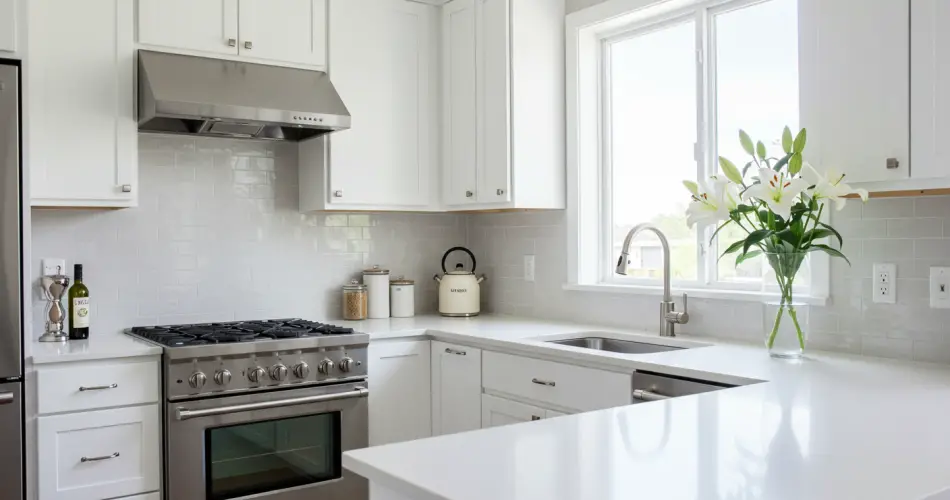Keeping a kitchen clean is one of the most important—and often most daunting—household chores. As the heart of the home, the kitchen is where meals are prepared and stored, making hygiene essential. However, it’s also the room where dirt, grease, and stubborn stains accumulate quickly, often in hard-to-reach corners. For many people, cleaning the kitchen can feel overwhelming, especially when time is limited. Fortunately, there’s a fast and effective method that allows you to clean your kitchen thoroughly in just 20 minutes, leaving more time for relaxation, hobbies, or socializing.
The Philosophy Behind Efficient Cleaning
This method draws inspiration from practices popular in countries like Japan and China, where organization and efficiency are key. In these cultures, cleaning is approached with careful planning, allowing people to maintain a spotless home without spending hours on tedious scrubbing. By following a structured process and using natural, effective cleaning solutions, even the most challenging kitchen tasks can be completed quickly and efficiently.
Step 1: Cleaning the Tiles
One of the first areas to tackle in the kitchen is the tiles. Cooking often leads to splatters and grease accumulating on the walls, forming a sticky, oily layer that can dull the appearance of your kitchen. However, cleaning these tiles doesn’t need to be complicated.
Start by preparing a simple cleaning solution: take a soft cloth, dip it in warm water, and add a small amount of ethyl alcohol. Wring out excess liquid so the cloth is damp but not dripping. Gently wipe the tiles, focusing on areas with visible grease or stains. In just a few minutes—around three—you’ll notice the tiles looking noticeably cleaner and free of streaks. This simple solution is effective because the alcohol dissolves grease while the warm water helps loosen dirt, making the process quick and easy.
Step 2: Sanitizing Appliances
Next, the focus shifts to the kitchen appliances, which are often the most challenging areas to clean. Refrigerators and ovens, in particular, tend to accumulate stubborn stains and grease that are difficult to remove with standard cleaning products. Fortunately, a homemade natural cleaner can achieve excellent results.
To make this solution, mix a couple of tablespoons of baking soda with the juice of one lemon. Add a spoonful of Marseille soap to the mixture, creating a paste-like consistency. Using a sponge, apply the solution inside the fridge and oven, paying extra attention to corners and areas with built-up grime. Once cleaned, wipe surfaces with a dry cloth. This process should take roughly eight minutes. The acidic properties of lemon juice, combined with the gentle abrasiveness of baking soda and the cleansing power of soap, effectively lift grease and stains while leaving appliances sanitized.
Step 3: Cleaning Countertops, Sink, and Stove
After appliances, it’s time to address the countertops, stove, and sink. These surfaces are in constant use and can harbor grease, food residue, and bacteria. A highly effective natural cleaning solution for these areas combines vinegar and tea tree oil (also known as melaleuca oil). Tea tree oil has natural antibacterial properties, while vinegar helps dissolve grease and remove stains.
To use, dampen a microfiber cloth with the vinegar and tea tree oil mixture, then wipe down all surfaces, including the stove, kitchen counters, and sink. With just five minutes of cleaning, these areas will be free from grime, shining, and hygienically safe.
Step 4: Cleaning the Floors
Finally, the kitchen floor can be cleaned quickly with another natural solution. Pour a glass of alcohol-based vinegar into a bucket of hot water. Stir the mixture well and use it to mop the floor. Vinegar not only cleans but also disinfects, leaving the floor sparkling without the need for harsh chemical detergents. This step should take about three minutes and ensures that the entire kitchen is fresh and clean.
Tips for Maintaining a Spotless Kitchen
While this method allows for a deep clean in just 20 minutes, maintaining a clean kitchen is easier when you adopt small, consistent habits:
-
Clean as you go: Wipe spills immediately to prevent stains from setting.
-
Organize supplies: Keep cloths, natural cleaners, and brushes readily accessible to reduce the time spent searching for tools.
-
Ventilate while cooking: Proper ventilation helps reduce grease buildup on walls and tiles.
-
Regular appliance cleaning: Even a quick weekly wipe can prevent grease and grime from becoming difficult to remove.
-
Use microfiber cloths: These are highly effective at picking up grease and dirt without leaving streaks or scratches.
Why Natural Cleaning Solutions Work
The effectiveness of these natural cleaners comes from their chemical properties. Vinegar and lemon juice are acidic, helping to break down grease and mineral deposits. Baking soda acts as a gentle abrasive to lift stains, while tea tree oil adds antibacterial and antifungal properties. Combined, these ingredients provide a powerful cleaning system without harsh chemicals, making your kitchen safer for food preparation and your family’s health.
Conclusion
Cleaning the kitchen doesn’t have to be an all-day chore. By following this structured 20-minute method, you can tackle tiles, appliances, countertops, sink, stove, and floors quickly and efficiently. Using natural, readily available ingredients like vinegar, lemon, baking soda, Marseille soap, and tea tree oil, you can achieve a spotless, hygienic kitchen without relying on chemical products.
With a little planning and the right approach, even the most challenging kitchen cleaning tasks can be completed quickly, giving you more time to enjoy your home, entertain friends, or simply relax. This simple, eco-friendly routine ensures your kitchen remains sparkling clean, hygienic, and welcoming every day.



